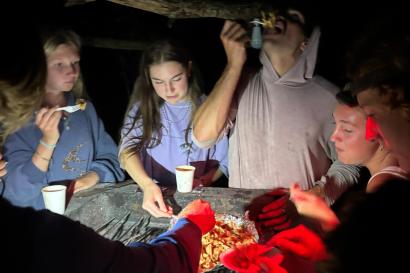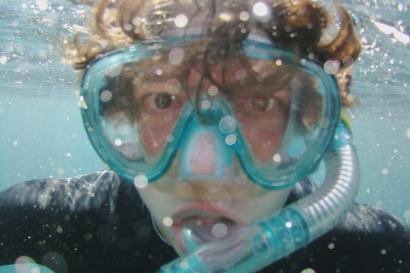It’s now been almost two weeks since I arrived in the Galápagos, and it really is paradise. I feel like I’ve been picked up and dropped into a BBC documentary, or between the pages of one of my biology textbooks.
So far my days here have been spent doing field research for my quantitative field ecology class in the mornings, spending time with friends on the beach in the afternoons, then wrestling with the spotty WiFi in the evenings to try and do some work. About once a week my class will have a field trip, and we’ll explore the highlands or other islands for the day.
I can’t put into words the natural beauty of the Galápagos in a way that someone reading this could get the whole picture. I also can’t capture it on my grainy iPhone 7 camera. But my friend Brendan (who is actually the other IES Abroad Blogger here in the Galápagos, and a very talented writer—I’ll include a link to his posts below) loaned me a book of short stories he had just finished reading yesterday. It inspired me to capture small moments of my time here so far in depth rather than try to graze over it all as a single post.
So here are three short anecdotes—hopefully these descriptions, along with some of the grainy pictures I previously mentioned, will give you an idea of where my study abroad experience has taken me for the next two months.
1.
First you hear them. Their faint but distant retching sounds coming from a distance, as if their twisted stomachs are waiting for vomit that will never come. The noises overlap each other in a chorus of discomfort that only grows louder as you press forward into the space between night and morning.
Then you smell them. An odor resembling cat food and dried feces, so strong it chokes out the ocean breeze with the same invisible hands that gag your throat. Still you continue on.
Then you see them. Squirming and writhing in huddled masses, dragging their thick lard-laden bodies over each other with complete disregard for what is beach and what is another. Some are slick as they emerge from the dark morning waters, while others are crusted with coarse sand. Even in the dim light of dawn, there is no mistaking the foulest of all things in the Galápagos—a beach full of sea lions.
___
One of the field assignments for our quantitative ecology class was analyzing sea lion feces for microplastics. This of course involved collecting it, which was done at 5am on the beaches where all the sea lions congregate before setting out into the ocean at daybreak. The research has been really interesting—but I have to say, sea lions aren’t my favorite animal here (though I’ll admit, the pups are adorable).
2.
Falling backwards off the boat clutching your regulator to your mouth, you watch the sky spin into ocean. Water hits the back of your head with a sharp slap; the sea reminds you from the beginning that it’s the one with the power here. A strong current drags you as you grasp the barnacle-crusted rope connecting the boat to the bottom.
You begin to pull yourself down. Hand over hand, you descend into colder water. Fish start to dart by, flicking tails striped with yellow and blue scales. Then you see it—the grisly remains of a ship sitting in pieces on the sea floor; the vestiges of a great vessel that’s surrendered itself calmly to the weathering of the ocean.
Swimming closer, smaller details become visible. The iron walls giving way to rusty holes. A type of sea plant with delicate spindly branches and tips topped with what look like white pom-poms. A tiny muppet-faced fish that pokes its head out of an old barnacle. You watch amazed at how a dying ship could give way to so much life.
Treading slowly through schools of yellow-tailed surgeonfish, this idea is only reinforced. You look under a fallen beam and see a giant Galápagos lobster; into the middle of a propellor and see an elusive octopus. Parrotfish circle your ankles curiously, opening and closing their beaked mouths.
You let yourself float for a moment in weightless suspension, watching life swarm around the shipwreck and letting the current sway you forwards and backwards. For one serene moment the barriers that keep you land-bound dissolve, and much like the ship itself, you allow yourself to be part of the ocean.
___
While I’m here, I decided to get my open water scuba diving certification. The Galápagos are known to be one of the best scuba spots in the world, and for good reason. In the three or four dives I’ve done to get my certification, I’ve seen an incredible amount of sea life in a way that you just can’t while snorkeling (though I’ve been doing plenty of that too).
3.
Scorched earth and sweat. Dripping from your upper lip to the dirt below, leaving small, caked splotches upon volcanic rocks. You shield your eyes against the angry sun as you peer forward down the path that winds its way through endless stickly bushes. Their starved skeletons hold few leaves, but they like it that way—here they must figure that bones don’t sweat.
You pass a rock, on top of which perches the dried carcass of a marine iguana. After weeks in the sun it has mummified into a creature of tan papery skin that pulls back against an unending smile. It watches you continue on, waiting on it’s black pedestal for the wind to take it.
More sweat drips. Your feet keep moving.
The trail curves near the edge of a rocky cliff, against which the ocean swells with full force, as if it were trying to reach up and wet the desert landscape above. A Nazca boobie and it’s baby stand at the edge, their throats quivering against the heat of the noon sun. You watch as the waves spray up behind them, white foam merging with their white feathers in your line of sight so that they look to be wearing some sort of regal headdress.
A minute more of walking and the trail opens up to more cliffsides. Stretching before you is an entire rocky field of birds. They add movement to the otherwise still landscape with a constant ruffling of feathers and overhead flight, forcing you to watch your step as you pass through.
The nesting grounds narrow and stretch into cliffs claimed by marine iguanas. They lean forwards and up on their clawed front feet to watch you warily as you walk, and suddenly you’re aware that you’re trespassing somewhere you don’t belong. On one of the few frontiers only lightly touched by humans, you decide it best to take in the views but stay only a short time—nature clearly rules Espanola island.
___
My favorite field trip so far was the day we spent snorkeling and walking the one path available to tourists on Española island, one of the uninhabited larger islands of the archipelago. It’s desert-like habitat and cliffs that look over the ocean make it truly the most beautiful place I’ve been to, and one that I firmly believe should remain closed to human activity other than careful research and guided walks on that path.
As promised, a link to Brendan’s IES abroad blog: https://www.iesabroad.org/blogs/author/1018991
The activities in this post were undertaken during the student’s free time and were not sponsored by IES Abroad.

Katie Vartenigian
<p>My name is Katie Vartenigian, and I’m a third-year biology student at the University of Maryland. After graduation, I want to go into science writing, preferably for a publication that allows me to travel. When I’m not studying, I like to read, write, play racquetball, and spend time with my friends. I can’t wait to study abroad this semester in the Galápagos and explore Ecuador!</p>








